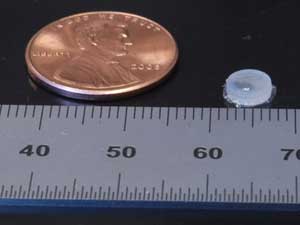Surgical removal of a tissue sample is now the standard for diagnosing cancer.
Such procedures, known as biopsies, are accurate but only offer a snapshot of the tumour at a single moment in time.
Monitoring a tumour for weeks or months after the biopsy, tracking its growth and how it responds to treatment, would be much more valuable, says Michael Cima, professor of materials science and engineering at the Massachusetts Institute of Technology (MIT), who has developed an implantable device that can do just that.
Cima and his colleagues recently reported that their device successfully tracked a tumour marker in mice for one month.
Such implants could one day provide up-to-the-minute information about what a tumour is doing - whether it is growing or shrinking, how it is responding to treatment, and whether it has metastasised or is about to do so.
'What this does is basically take the lab and put it in the patient,' said Cima, who is also an investigator at the David H Koch Institute for Integrative Cancer Research at MIT.
The devices, which could be implanted at the time of biopsy, could also be tailored to monitor chemotherapy agents, allowing doctors to determine whether cancer drugs are reaching the tumours.
They can also be designed to measure pH (acidity) or oxygen levels, which reveal tumour metabolism and how it is responding to therapy.
'With current tools for detecting whether a tumour has spread, such as biopsy, by the time you have test results it's too late to prevent metastasis,' said Cima.
'This is one of the tools we're going to need if we're going to turn cancer from a death sentence to a manageable disease,' he added.
In Cima's study, human tumours were transplanted into the mice, and the researchers then used the implants to track levels of human chorionic gonadotropin, a hormone produced by human tumour cells.
The cylindrical, 5mm implant contains magnetic nanoparticles coated with antibodies specific to the target molecules.
Target molecules enter the implant through a semi-permeable membrane, bind to the particles and cause them to clump together.
That clumping can be detected by MRI (magnetic resonance imaging).
The device is made of polyethylene, which is commonly used in orthopaedic implants.
The semi-permeable membrane, which allows target molecules to enter but keeps the magnetic nanoparticles trapped inside, is made of polycarbonate.
Cima said he believes an implant to test for pH levels could be commercially available in a few years, followed by devices to test for complex chemicals such as hormones and drugs.

MIT researchers have developed a device that can be implanted into a tumour to monitor how it responds to treatment




Poll: Should the UK’s railways be renationalised?
I think that a network inclusive of the vehicles on it would make sense. However it remains to be seen if there is any plan for it to be for the...